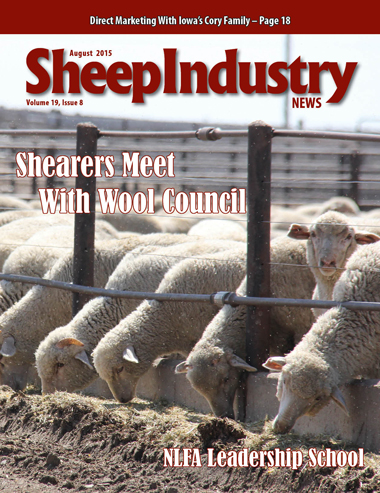Joint Sessions With Shearers Dominate Wool Council Meeting
Kyle Partain, Sheep Industry News Editor
Ten years ago, members of ASI’s Wool Council sat down with U.S. sheep shearers and began a collaborative effort to develop a slate of programs that would benefit the entire wool industry – the American Shearers Council was developed, mill tours for shearers conducted, a shearing manual developed and on-site personnel programs, to name a few. It was time for another face-to-face meeting and a dozen shearers joined the Wool Council for its summer meeting in early July.
There’s no doubt the job of marketing U.S. wool is easier when shearers are properly equipped, staffed and trained to present fleeces in their best light, which is what made the joint session of the Wool Council and a select group of shearers on July 8-9 in Denver so important.
“The shearers play just as important a role in the process as the producers,” said Wool Council Chair Ken Wixom. “We need everyone working together to produce the best wool possible for both domestic and international buyers. And that’s why we decided to invite a dozen shearers to the meeting.”
As attendees filed into the first meeting on July 8, they found assigned seats that alternated council members and shearers in hopes of spurring conversation throughout the day. Breakout groups also helped produce a list of issues that shearers are facing on a daily basis, as well as possible solutions for many of the problems.
Some of the problems include:
• A shortage of qualified labor
• Competition from crews operating illegally
• Little support from the industry as a whole
• Lack of adequate facilities at the farm/ranch
• Soaring costs of liability/worker’s comp insurance
• Growing size of sheep within the U.S., particularly rams
• Scheduling issues, especially during bad weather
• Decreasing wool sheep population, less opportunities
• Lack of advanced training programs in the U.S.
Veteran shearer Bernie Fairchild of Idaho runs three crews in a family-owned business that began with his dad and uncle back in the 1940s. His crews shear at some of the largest sheep operations in the western U.S. and his producers generally have learned how he needs things setup when shearers arrive on scene. But through the years he’s seen plenty of producers who weren’t ready for shearing day.
“We’re on a very tight schedule,” he said. “We’re shearing at a time when weather can be bad and create delays. The last thing we need is to be delayed more because a grower isn’t ready.”
Corrals, shearing sheds, etc., should be setup and ready to go before the shearing crew arrives, he said. Producers should also plan to have plenty of manpower on site to keep sheep moving to the shearers. If they plan to brand that day, as well, then even more help will be necessary.
Black wool and black face sheep need to be separated out, or there needs to be a system in place for separating them before they are sent to the shearers. This provides the best environment for harvesting the wool.
Playing by the rules can also put Fairchild and other operators of large shearing crews at a disadvantage. Fairchild’s wife, Terri, handles all of the H-2A paperwork to bring shearers in from Uruguay. Costs can skyrocket quickly thanks to various government requirements concerning pay and living conditions for these foreign workers. Crews that bring foreign workers in illegally can cut corners and save money, making it difficult for Fairchild and others like him to compete.
“The producer needs to know that he’s putting himself at risk by hiring these crews,” Fairchild said. “They might not have liability or worker’s comp insurance and if something happens, then it’s the producer who is going to be liable.”
The Wool Council meeting might not have solved all of these problems, but the conversations led to a wealth of ideas.
“One thing I take away from this is that the shearers have a real passion for producing a valuable commodity,” said ASI Secretary/Treasurer Benny Cox of Texas. “Just like the producers, they’ve got some issues that we need to address to make life better for everyone.”
The council recommended the 2015-16 fiscal year budget to the ASI Executive Board and heard updates on the state of U.S. wool as it pertains to product development, quality improvement, international sales and military programs.
Shearers Prefer Plastic Ear Tags
The chief concern of the shearers attending the Wool Council’s summer meeting was the use of metal ear tags by producers. If the shearers had their way, use of the tags would be discontinued immediately.
“They’re dangerous,” said shearer Cliff Hoopes of Wyoming. “Sometimes they aren’t even visible, and nothing good happens when a shearer hits one of those tags.”
Hoopes knows first-hand the danger the tags can cause. One of his shearers severed “every tendon, nerve, ligament and the main vein in his wrist when an uncooperative ram caused the shearer’s clippers to collide with a metal ear tag.
“The ram flipped his head and my shearer came up behind two metal ear tags on the bottom,” Hoopes said. “His handpiece locked up on those tags, then shot into his wrist. We had to life flight him from Rock Springs (Wyo.) to Salt Lake City, and his medical bills alone totaled more than $400,000. And, he’ll never be able to shear sheep again.”
White plastic tags are available free – just like the metal tags – through USDA/APHIS. ASI will further explore the use of metal ear tags in the months to come.


